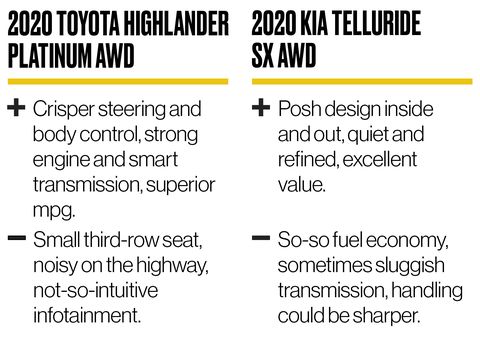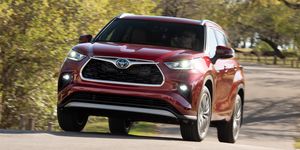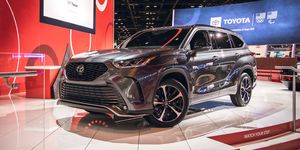Three-row SUVs aren’t boring. In fact, they’re evolving so quickly that every time we check in things have changed. Mainstream brands continue to introduce new three-row SUVs that are real rivals to what premium brands are selling. Take the new 2020 Toyota Highlander and 2020 Kia Telluride, at their highest trim levels both could easily wear a Lexus or Genesis badge in both appearance and amenities.
Now, we do have to mention that these two SUVs have pretty much the same people-hauling mission as minivans. But the Telluride and Highlander’s luxury bent and design gives them more flair than minivans offer. To find out which three-row is best we pitted our current class favorite and the 10Best winning Kia Telluride against the new Highlander.
The Matchup
You’ve surely heard the name Highlander before, but perhaps you’ve missed us shouting from the rooftops about the new Telluride. Introduced last year as a 2020 model, it’s the brand’s largest SUV and offers bold styling, space, and a long list of standard and optional features.
The Highlander has been playing this game longer, but it is also new for 2020. The fourth-generation Highlander makes the switch to Toyota’s modular platform, called TNGA, and features a more—ahem—unique exterior design than any Highlander before it. Given that even the old, outgoing Highlander was the best-selling three-row SUV in 2019, this new model has big shoes to fill.
On the Road
While some automakers now equip its three-row SUVs with turbocharged four-cylinder engines, Toyota and Kia have stuck with naturally aspirated V-6s. The Telluride’s is a 3.8-liter V-6 with 291 horsepower, while the Highlander’s is a 3.5-liter V-6 with 295 horsepower. Similar specs aside, the Highlander’s crisper shifts had us thinking that it felt more responsive. But the data is very similar, with the Telluride just 0.2-second slower in our 30-to-50-mph passing test, and 0.7-seconds quicker in the 50-to-70-mph metric. The Toyota gets off the line slightly better, with a 60-mph time of 6.7 seconds to the Telluride’s 7.1, but the Telluride gains on it from there, pulling equal at the quarter-mile, which both hit in 15.3 seconds. To 100 mph, the Telluride is ahead by a second, and keeps pulling further ahead from there. In our rolling-start, 5-to-60-mph test, which is a better gauge of the feeling of quickness in normal driving, the two are near equals, with the Kia at 7.1 seconds and the Toyota 7.2. The short version: There’s no compelling reason to pick one of these over the other for reasons of acceleration.
Both of these SUVs impressed us with their driving dynamics, but for different reasons. We appreciate the Telluride’s quiet and refined demeanor, it has the plush ride quality and hushed cabin of a true luxury SUV. The Highlander, on the other hand, is sportier and more responsive. There’s more driver engagement as you push it into corners. It has direct steering and a firm brake pedal. But each could learn some lessons from the other, as the softer Kia would benefit from tighter body control when cornering and the less-refined Toyota could stand to be quieter when cruising at highway speeds. (Our sound-level measurement at a 70-mph cruise showed 67 decibels for the Kia and a substantially louder 69 for the Toyota.)
When you are cruising along at highway speeds, the Highlander returns better fuel economy than the Telluride. In addition to scoring higher in EPA testing, the Toyota delivered an impressive 28 mpg in our steady-state 75-mph highway fuel economy test. The Telluride managed to match its EPA highway rating in our test, delivering 24 mpg at 75 mph. Should you want even more fuel economy, the Highlander offers an even more efficient hybrid model, while the Telluride does not.
The Inside View
The Kia has a boxy and classic SUV shape. There’s some Volvo and Land Rover in the design and it’s more pleasing to our eyes than is the Highlander. But that upright shape has the added benefit of giving the Telluride’s interior a feeling of spaciousness; it’s the one we’d pick for a long road trip. The Telluride has more head- and legroom in both the second and third rows, and, like in a big house, its large windows and tall ceiling exaggerate the feeling of airiness. Sitting inside the Highlander feels like entering a cramped cottage in comparison: the roofline is lower and the windows are narrower, creating a relatively claustrophobic feel and making it more difficult to climb into the third row of seats.
We’d much rather be a fifth, sixth, or seventh passenger in the wayback of the Telluride than the Highlander. The Kia offers a reasonably comfortable seating position even for adults, while the Toyota forces your knees into your chest. Comfort in the second-row captain’s chairs is about even in these two models, and both offer chairs with a wide range of adjustability including seatback recline and slide. (Both SUVs are also available with a second-row bench seat in place of captain’s chairs that ups passenger capacity to eight.) The Telluride—no surprise—also holds the advantage in cargo capacity, with 21 cubic feet behind its third row to the Highlander’s 16 cubic feet.
But what about you, the driver? Again, we give the nod to the Kia here due to its pleasingly simple yet rich-looking dashboard. Climate controls are logical and easy to use and the large touchscreen infotainment system features a crisp display and logically arranged controls and menus. The Highlander is a match for the Kia in terms of materials quality—both SUVs have high-quality plastics, leather trim, and even carpets—but the Toyota is a bit busier, with a number of contrasting shapes, colors, and textures. It has a similarly large touchscreen as the Kia, but its menu structure is a bit more confusing and it’s not as clear in its graphical presentation. Still, both have interiors that would be at home in the premium segment.
The Bottom Line
Fully loaded three-row SUVs like the Highlander Platinum and Telluride SX require about $50,000. If that triggers an arrhythmia, more basic versions can be had in the low-$30,000 range. In this test, the Telluride, with an as-tested price of $46,910, has a price advantage of thousands over the Highlander, at $51,112, despite being just as well equipped. Still, the Toyota offers a slightly sportier driving experience than the Kia. But the Kia is a clear winner. It looks and feels premium, it goes about its business unobtrusively and with grace befitting a more expensive vehicle, and it costs thousands less than its newest and strongest competitor.
Source: Reviews - aranddriver.com












